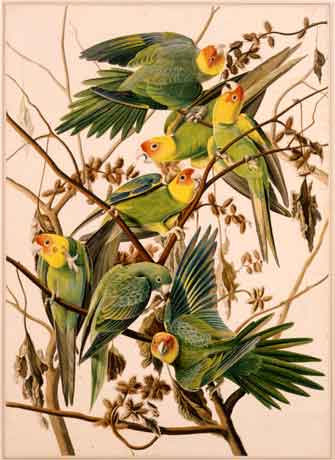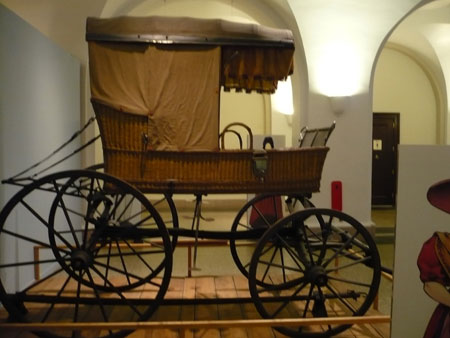The New-York Historical Society owns all of the 435 original watercolors from which the aquatint engravings in John James Audubon’s Birds of America were made. Being fragile and sensitive to light, the watercolors cannot be shown for extended periods. However, the museum is currently displaying about 40 of these magnificent artworks through March 16, and they are well worth the museum’s $10 admission. (Incidentally, that’s half the price of what many of NYC’s great cultural institutions charge, and you’ll notice it’s even less than a movie ticket.)

Carolina Parakeet (Conuropsis carolinensis), ca. 1825
Havell plate no. 26.
Watercolor, graphite, pastel, gouache, and black ink with scratching out and selective glazing on paper, laid on thin board.
The exhibit also includes the museum’s copy of the full-size Birds of America on a specially designed display cabinet. Though these iconic pictures are to some extent familiar to most of us, only by seeing the hugeness of the book can you appreciate the impact they originally made. (No flipping pages, though – it’s under glass.) Samples of the popular, much smaller quarto edition are also shown.
The exhibit also pairs some of the drawings with recorded songs of the depicted birds. And finally, there’s a nice gilt-framed video display on what looks like one of those led screens of a selection of the images juxtaposed with video of the same birds in nature – a marvelous way to appreciate Audubon’s achievement.
A poignant aspect of the show is that some of the birds in the paintings, like the passenger pigeon, are extinct. Many others are threatened. The descriptions also note some “success stories,” birds whose populations have rebounded after being drastically reduced.
The only downside of the show is that because of the low light in the display room, it’s difficult for aged, floater-occluded mammalian eyes to read the placards. I have this problem in all museums, but it was especially difficult at this exhibit.
Really getting my $10 worth, I also saw the museum’s small but densely packed exhibit about the Marquis de Lafayette’s triumphant 1824-1825 visit to the United States – a country he had helped birth the previous century, when he was only in his 20s. Objects on display included Lafayette’s copy of the Declaration of Independence, letters from him to George Washington, and this carriage, which was used to ferry him from town to town in New England in 1825.

The N-YHS’s more permanent displays include many iconic paintings, including Thomas Cole’s spectacular “The Course of Empire” series, as well as sculpture, silver, porcelain, and a lot more. Finally, the museum is also running a 9-11 exhibit, which includes some pieces of wreckage, interesting to look at. But I didn’t spend any time at the 9-11 photography and video displays – this is still too raw for me even after six and a half years. It’s a livid memory, not a matter of history. I would, however, recommend the exhibit for out of town visitors.
On the way home I snapped this shot of some gulls flying around Central Park. This past Friday, we had the only significant snowfall of the year so far. It looked especially nice in the park.
